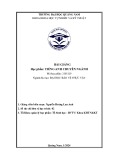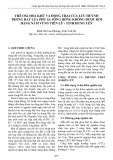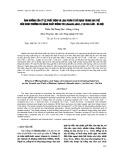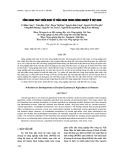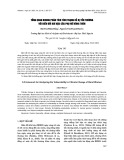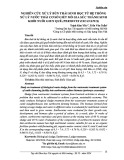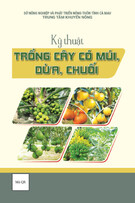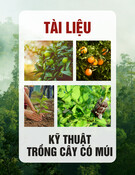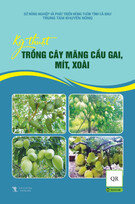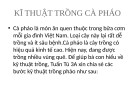
TNU Journal of Science and Technology
229(07): 133 - 140
http://jst.tnu.edu.vn 133 Email: jst@tnu.edu.vn
RICE GRAIN TRAIT ESTIMATION USING COLOR SPACE CONVERSION
AND DEEP LEARNING-BASED IMAGE SEGMENTATION
Chu Bao Minh, To Thi Mai Huong, Tran Giang Son*
University of Science and Technology of Hanoi - Vietnam Academy of Science and Technology
ARTICLE INFO
ABSTRACT
Received:
23/4/2024
Accurately extracting traits from rice grains is of importance for effective
crop management and yield estimation, providing valuable understanding
for improving agricultural practices. However, manual intervention in
these tasks is labor-intensive, time-consuming, and error-prone. This
research proposes a new approach that leverages low-cost digital cameras
and deep learning technology for counting and extracting rice grain traits.
Our study introduces a preprocessing step to separate rice grain regions
from the input image background using color space conversion. After
that, a deep learning image segmentation model based on YOLOv8 is
utilized for the extraction of both the number and morphological traits of
the grains. The accuracy of the proposed method was experimented on 88
different rice varieties provided by the Plant Resource Center in Hanoi.
The experimental results show that the proposed approach is high-
accurate and high-throughput for low-cost extraction of rice grain traits
from color digital images, which is potentially helpful in facilitating
effective evaluation in rice breeding programs and functional gene
identification of rice varieties.
Revised:
10/6/2024
Published:
11/6/2024
KEYWORDS
Rice grain traits
Color space conversion
Deep learning
Image segmentation
YOLOv8
ƢỚC LƢỢNG KIỂU HÌNH HẠT LÚA BẰNG PHƢƠNG PHÁP ĐỔI HỆ MÀU
VÀ PHÂN ĐOẠN ẢNH DỰA TRÊN HỌC SÂU
Chu Bảo Minh, Tô Thị Mai Hƣơng, Trần Giang Sơn*
Trường Đại học Khoa học và Công nghệ Hà Nội - Viện Hàn lâm Khoa học và Công nghệ Việt Nam
THÔNG TIN BÀI BÁO
TÓM TẮT
Ngày nhận bài:
23/4/2024
Việc trích chọn đặc điểm kiểu hình của hạt lúa một cách chính xác là
việc rất quan trọng trong việc quản lý và ước lượng năng suất trồng lúa
một cách hiệu quả, đồng thời mang lại những hiểu biết quý giá để cải tiến
các phương pháp nông nghiệp. Tuy nhiên, thực hiện thủ công các công
việc này là rất tốn công sức, tốn thời gian và dễ gây sai sót. Nghiên cứu
này đề xuất một phương pháp mới sử dụng máy ảnh kỹ thuật số giá rẻ và
công nghệ học sâu để đếm và trích chọn các đặc điểm kiểu hình của hạt
lúa. Nghiên cứu của chúng tôi giới thiệu một bước tiền xử lý để phân tách
các vùng hạt lúa từ nền ảnh đầu vào bằng cách chuyển đổi không gian
màu. Sau đó, một mô hình phân đoạn ảnh dựa trên học sâu dùng
YOLOv8 được sử dụng để đếm số lượng và trích chọn các đặc điểm kiểu
hình của hạt lúa. Độ chính xác của phương pháp đề xuất được thử nghiệm
trên 88 giống lúa khác nhau được cung cấp bởi Trung tâm Tài nguyên
Thực vật tại Hà Nội. Kết quả thực nghiệm cho thấy phương pháp đề xuất
có độ chính xác cao và có khả năng xử lý lượng lớn ảnh màu với chi phí
thấp để trích chọn đặc điểm kiểu hình của hạt lúa. Kết quả này có tiềm
năng trong việc hỗ trợ các chương trình lai tạo giống lúa và xác định các
gene chức năng của các giống lúa.
Ngày hoàn thiện:
10/6/2024
Ngày đăng:
11/6/2024
TỪ KHÓA
Kiểu hình hạt lúa
Đổi hệ màu
Học sâu
Phân đoạn ảnh
YOLOv8
DOI: https://doi.org/10.34238/tnu-jst.10191
* Corresponding author. Email: tran-giang.son@usth.edu.vn






